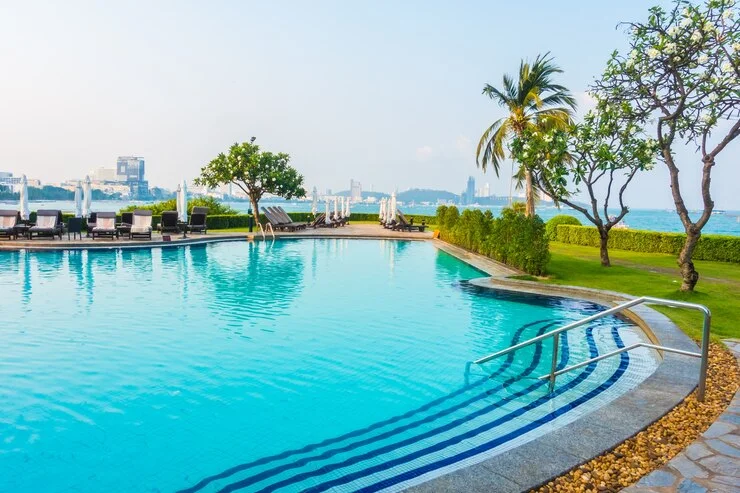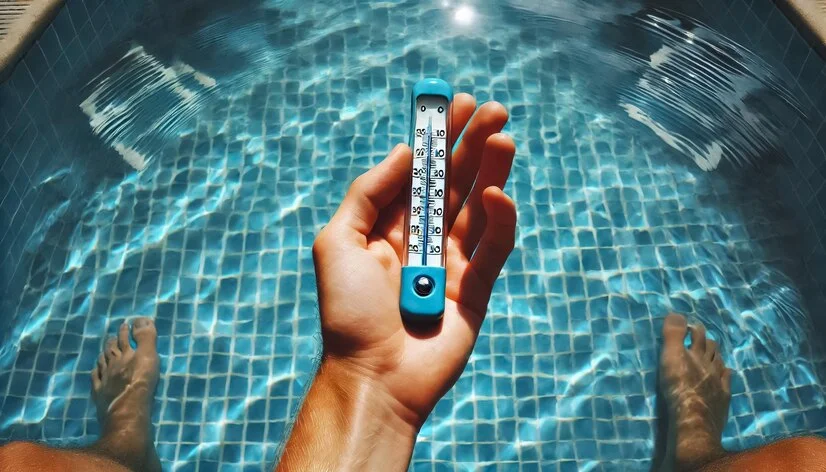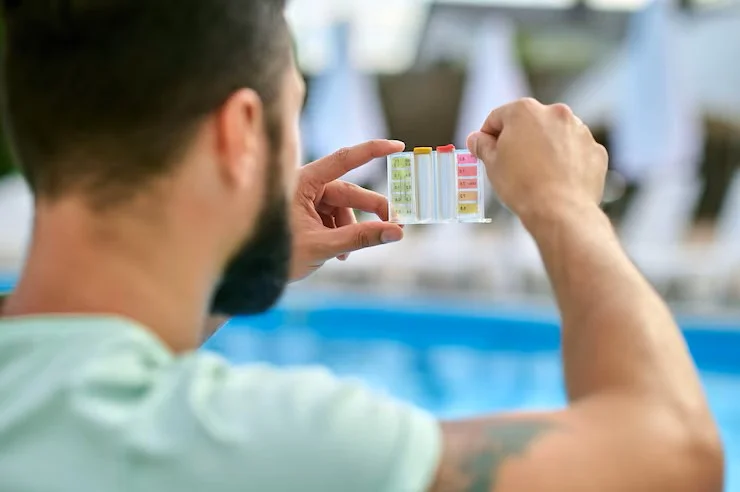Table of Contents
Alkalinity in Your Pool
Introduction
Maintaining optimal water chemistry is vital for a clean, safe, and enjoyable swimming pool experience. One of the key elements in pool maintenance is managing alkalinity. Alkalinity acts as a buffer, stabilizing the pH levels in your pool water. However, when the alkalinity levels rise too high, it can lead to several issues, including cloudy water, scaling on pool surfaces and equipment, and difficulty in adjusting the pH levels. This comprehensive guide will walk you through everything you need to know about lowering alkalinity in your pool, including step-by-step instructions, common causes of high alkalinity, and preventive measures to keep your pool water perfectly balanced.

Understanding Alkalinity in Pool Water
Total Alkalinity (TA) refers to the concentration of alkaline substances in the pool water, primarily bicarbonates, carbonates, and hydroxides. These substances help buffer the water, preventing drastic changes in pH levels. Ideally, your pool’s alkalinity should be within the range of 80 to 120 parts per million (ppm). When alkalinity levels exceed this range, it can cause several problems:
- pH Imbalance: High alkalinity makes it difficult to maintain a stable pH, leading to pH levels that are too high (basic) or too low (acidic).
- Cloudy Water: Excessive alkalinity can cause calcium and other minerals to precipitate out of the water, resulting in cloudy or murky water.
- Scaling: High alkalinity can lead to the formation of scale on pool surfaces, plumbing, and equipment, reducing their efficiency and potentially leading to costly repairs.
- Skin and Eye Irritation: Unbalanced alkalinity can also cause irritation to swimmers, leading to red eyes and dry, itchy skin.
Why You Need to Lower Alkalinity in Your Pool
Lowering the alkalinity in your pool is crucial for maintaining overall water quality and ensuring a pleasant swimming experience. Properly balanced alkalinity helps:
- Stabilize pH Levels: By keeping alkalinity within the ideal range, you make it easier to maintain the pH level, ensuring that the water is neither too acidic nor too basic.
- Prevent Cloudiness: Balanced alkalinity prevents the formation of cloudy water, keeping your pool crystal clear.
- Avoid Scaling: Proper alkalinity levels reduce the risk of scale buildup on pool surfaces and equipment, which can extend the life of your pool system.
- Enhance Swimmer Comfort: Balanced water chemistry ensures a more comfortable swimming experience, minimizing skin and eye irritation.
How to Test Alkalinity in Your Pool
Before you can take steps to lower the alkalinity, you need to determine the current alkalinity level in your pool. Here’s how to accurately test your pool’s alkalinity:

- Use a Reliable Pool Test Kit: Invest in a high-quality pool test kit that includes a test for total alkalinity. These kits typically come with reagents that, when added to a water sample, change color based on the alkalinity level.
- Collect a Water Sample: Use a clean container to collect a water sample from your pool. To get an accurate reading, take the sample from about 18 inches below the surface and away from pool returns or skimmers.
- Perform the Alkalinity Test: Follow the instructions provided with your test kit. Typically, you’ll add a specific number of reagent drops to the water sample and then compare the color change to a reference chart to determine the alkalinity level.
- Record and Analyze the Results: Write down the alkalinity level. If it exceeds 120 ppm, you’ll need to take steps to lower it.
Steps to Lower Alkalinity in Your Pool
If your pool’s alkalinity is too high, it can be corrected using specific chemicals and techniques. Here’s a detailed guide on how to lower the alkalinity in your pool:
1. Use Muriatic Acid to Lower Alkalinity
Muriatic acid: (also known as hydrochloric acid) is the most common and effective chemical used to lower alkalinity in pool water. Here’s how to use it safely and effectively:
- Safety Precautions: Muriatic acid is a strong chemical that can cause burns and emits harmful fumes. Always wear protective gear, including gloves, goggles, and long sleeves. Work in a well-ventilated area and avoid inhaling the fumes.
- Dilute the Acid: In a plastic bucket, carefully dilute the muriatic acid with water. The recommended ratio is one part acid to ten parts water. Always add acid to water, never water to acid, to prevent a dangerous reaction.
- Add the Acid to the Pool: Slowly pour the diluted muriatic acid into the deep end of the pool. Distribute it evenly around the pool’s perimeter to ensure thorough mixing. It’s best to add the acid while the pool pump is running to circulate the water.
- Wait and Retest: Allow the water to circulate for at least 4 hours before testing the alkalinity again. Depending on the results, you may need to repeat the process until the desired alkalinity level is reached.
2. Use Dry Acid as an Alternative
- Dry acid: (sodium bisulfate) is another option for lowering alkalinity, especially for those who prefer a less caustic alternative to muriatic acid. Here’s how to use dry acid:
- Safety First: While dry acid is safer to handle than muriatic acid, it’s still important to wear protective gloves and goggles. Avoid inhaling the powder and wash your hands thoroughly after handling.
- Pre-Dissolve the Acid: In a bucket of water, dissolve the recommended amount of dry acid. Follow the manufacturer’s instructions for the correct dosage based on your pool’s alkalinity level and volume.
- Add the Solution to the Pool: Slowly pour the dissolved dry acid solution into the deep end of the pool. Make sure the pool pump is running to ensure even distribution.
- Wait and Retest: After 4 hours, retest the pool’s alkalinity. If it’s still too high, repeat the process until the desired level is achieved.
3. Using Aeration to Fine-Tune pH Levels
When you lower alkalinity, the pH of the water often drops as well. If the pH falls below the recommended range (7.2 to 7.8), you can raise it without affecting the alkalinity by using aeration. Aeration involves increasing the water’s exposure to air, which helps carbon dioxide escape and raises the pH level naturally. Here’s how you can aerate your pool:

- Turn on Water Features: If your pool has features like fountains, waterfalls, or jets, turn them on to increase water movement and aeration.
- Use a Pool Brush: Brushing the walls and floor of your pool can also help to increase aeration by agitating the water.
- Install an Air Pump: If your pool doesn’t have built-in aeration features, consider using an air pump or other aeration devices to introduce more air into the water.
While this method is slower than adding chemicals, it can effectively fine-tune your pool’s pH without altering the alkalinity.
How Much Acid to Add to Lower Alkalinity
The amount of acid you need to add depends on your pool’s current alkalinity level, the size of the pool, and the type of acid you’re using. Here are some general guidelines:
- For Muriatic Acid: To lower the alkalinity by 10 ppm in a 10,000-gallon pool, you’ll typically need about 1.5 pints of muriatic acid.
- For Dry Acid: To lower the alkalinity by 10 ppm in a 10,000-gallon pool, use approximately 1.25 pounds of dry acid.
Always start with a smaller amount and gradually add more if necessary, testing the water after each addition.
Common Causes of High Alkalinity
Understanding the causes of high alkalinity can help you prevent it from occurring in the first place. Common causes include:
- Using Alkaline Pool Chemicals: Adding too many alkaline chemicals, such as sodium bicarbonate (baking soda), can raise the alkalinity level.
- Hard Water: If your pool water comes from a source with high mineral content (hard water), it may naturally have high alkalinity.
- Overuse of Stabilizers: Cyanuric acid, a common pool stabilizer, can contribute to increased alkalinity if used excessively.
Preventing High Alkalinity in the Future
Once you’ve successfully lowered the alkalinity in your pool, take these preventive measures to maintain balanced water chemistry:
- Regular Testing: Test your pool’s alkalinity at least once a week using a reliable test kit. This helps you catch any imbalances early and make adjustments before they become significant issues.
- Balanced Chemical Additions: When adding chemicals to your pool, follow the manufacturer’s instructions carefully. Avoid overusing products that can raise alkalinity, such as sodium bicarbonate or stabilizers.
- Proper Circulation: Ensure your pool’s filtration and circulation systems are working correctly. Poor circulation can lead to uneven distribution of chemicals and imbalances in alkalinity.
- Monitor Fill Water: If you’re using water from a well or a hard water source, consider using a pre-filter or treating the water before adding it to your pool. This can help reduce the introduction of minerals that contribute to high alkalinity.
FAQ
1. What is alkalinity in pool water?
- Alkalinity in pool water refers to the concentration of alkaline substances, primarily bicarbonates, carbonates, and hydroxides, which act as a buffer to stabilize pH levels.
2. Why is high alkalinity in a pool a problem?
- High alkalinity can lead to cloudy water, scaling on pool surfaces and equipment, difficulty in maintaining stable pH levels, and potential skin and eye irritation for swimmers.
3. How do I test the alkalinity in my pool?
- You can test the alkalinity in your pool using a reliable pool test kit that includes a test for total alkalinity. Follow the instructions to collect a water sample and use the reagents to determine the alkalinity level.
4. What chemicals can I use to lower alkalinity in my pool?
- The most common chemicals used to lower alkalinity are muriatic acid (hydrochloric acid) and dry acid (sodium bisulfate).
5. How much acid should I add to lower the alkalinity in my pool?
- The amount of acid needed depends on your pool’s current alkalinity level and size. Generally, to lower alkalinity by 10 ppm in a 10,000-gallon pool, you’ll need about 1.5 pints of muriatic acid or 1.25 pounds of dry acid.
6. Can I lower alkalinity without affecting the pH?
- It’s difficult to lower alkalinity without affecting pH, but if the pH drops too low after adding acid, you can raise it without affecting alkalinity by using aeration methods, such as turning on water features or using an air pump.
7. What are the common causes of high alkalinity in a pool?
- Common causes include overuse of alkaline chemicals, hard water, and excessive use of stabilizers like cyanuric acid.
8. How often should I test my pool’s alkalinity?
- It’s recommended to test your pool’s alkalinity at least once a week to ensure balanced water chemistry.
9. Can high alkalinity be prevented?
- Yes, high alkalinity can be prevented by regularly testing your water, avoiding overuse of alkaline chemicals, ensuring proper pool circulation, and monitoring the quality of fill water.
10. What should I do if my pool’s alkalinity is too low?
- If your pool’s alkalinity is too low, you can raise it by adding sodium bicarbonate (baking soda) according to the recommended dosage for your pool’s size.
Conclusion
Managing the alkalinity in your pool is a crucial aspect of maintaining clear, balanced water that is safe for swimmers and easy on your pool equipment. By understanding how to
test for alkalinity, how to lower it using the correct chemicals, and how to prevent it from rising again, you can ensure that your pool remains in excellent condition all season long. Regular maintenance, vigilant testing, and proper chemical management are the keys to achieving the perfect pool water balance, allowing you to enjoy a clean, sparkling pool with minimal hassle.

